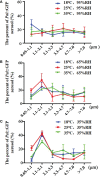Effect of temperature and humidity on dynamics and transmission of Pseudomonas amygdali pv. lachrymans aerosols
- PMID: 36818834
- PMCID: PMC9936812
- DOI: 10.3389/fpls.2023.1087496
Effect of temperature and humidity on dynamics and transmission of Pseudomonas amygdali pv. lachrymans aerosols
Abstract
Cucumber angular leaf spot (ALS) disease, caused by Pseudomonas amygdali pv. lachrymans (Pal), is an emerging disease with a high incidence that causes severe damage to cucumber worldwide. Bacterial aerosols play a crucial role in the epidemiology of greenhouse ALS disease. However, little is known about the influence of temperature and relative humidity (RH) on the dynamics of Pal in aerosols. A study was conducted to investigate the relationships between the concentration of Pal aerosols and their dependence on temperature and RH in aerosol chambers and greenhouses. The results demonstrated that temperature and RH are both significant factors influencing the release amount, survival time and infectivity of Pal in aerosols, while RH has a greater influence on particle size than temperature across the range of conditions tested. The release amount and survival time of Pal in aerosols under high RH (95%) and low temperature (≤ 25°C) conditions were significantly higher than those under low RH (35%) and high temperature (35°C) conditions. The highest release amount of Pal aerosol (96 CFU/m3) and highest survival rate (98.41%) were found at 18°C and 95% RH, while the highest disease index (DI = 60.9) caused by Pal aerosol was found at 25°C and 95% RH. In addition, Pal aerosols presented a larger diameter (4.7->7.0 μm) under high RH (95% RH) than under dry conditions (≤ 65% RH). These findings will play a crucial role in elucidating the influence of environmental parameters on the dynamics and transmission of Pal in aerosols. Based on our findings, preliminary recommendations for controlling airborne Pal spread involve controlling air temperature and RH, which will contribute to the effective alleviation and control of cucumber ALS disease.
Keywords: Pseudomonas amygdali pv. lachrymans; bioaerosol; cucumber angular leaf spot disease; relative humidity; temperature.
Copyright © 2023 Chai, Yuan, Li, Li, Shi, Xie and Li.
Conflict of interest statement
The authors declare that the research was conducted in the absence of any commercial or financial relationships that could be construed as a potential conflict of interest.
Figures






References
-
- Afsharnia M., Biglari H., Mohammadzadeh A., Shakeri H. (2018). Identifying and determining dispersion boundary bio-aerosols of bacterial and fungal pathogens from municipal waste collection containers. Arch. Hyg. Sci. 7, 39–46. doi: 10.29252/ArchHygSci.7.1.39 - DOI
-
- Aguilera S., Alvarez-Morales A., Murillo A., Hernandez-Flores J. L., Bravo J., Torre-Zavala S. D. (2017). Temperature-mediated biosynthesis of the phytotoxin phaseolotoxin by Pseudomonas syringae pv. phaseolicola depends on the autoregulated expression of the phtABC genes. PloS One 12 (6), e0178441. doi: 10.1371/journal.pone.0178441 - DOI - PMC - PubMed
-
- Ariya P. A., Amyot M. (2004). New directions: the role of bioaerosols in atmospheric chemistry and physics. Atmos. Environ. 38, 1231–1232. doi: 10.1016/j.atmosenv.2003.12.006 - DOI
LinkOut - more resources
Full Text Sources
Miscellaneous

